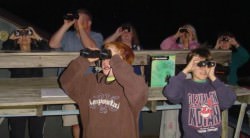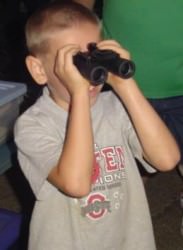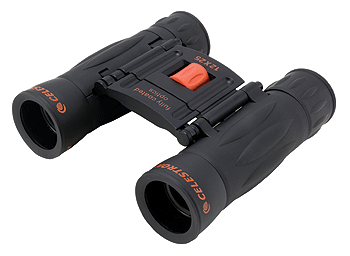Are you looking for a great pair of binoculars for kids – but want optics good enough for demanding adults? Then you really need to check out the Celestron 12X25 UpClose binoculars for astronomy . These mighty little midgets have a whole lot going for them, including a great view at a moment’s notice.
 When I first picked up a pair of Celestron 12X25 binoculars, I wasn’t expecting very much. After all, we’re talking about a pair of binoculars that when folded in their case are small enough to easily fit in your jacket or jeans pocket comfortably. What could something that small really do? As always, I give every product I test the benefit of the doubt and I was about to find out. Thanks to the generosity of OPT, several pairs of these were donated to benefit our children’s binocular observing program at the Observatory and it was time to hand them out along with the other binoculars we traditionally use. As the kids inspected their binoculars, I inspected mine, too. Since my binocular experience tends toward astronomy, I wasn’t overly familiar with the roof prism design and I was curious. Could something so small really be of practical use? And, what’s more, could something that inexpensive be of lasting quality? Well, for a person that’s usually the one giving lessons, I was about to get one.
When I first picked up a pair of Celestron 12X25 binoculars, I wasn’t expecting very much. After all, we’re talking about a pair of binoculars that when folded in their case are small enough to easily fit in your jacket or jeans pocket comfortably. What could something that small really do? As always, I give every product I test the benefit of the doubt and I was about to find out. Thanks to the generosity of OPT, several pairs of these were donated to benefit our children’s binocular observing program at the Observatory and it was time to hand them out along with the other binoculars we traditionally use. As the kids inspected their binoculars, I inspected mine, too. Since my binocular experience tends toward astronomy, I wasn’t overly familiar with the roof prism design and I was curious. Could something so small really be of practical use? And, what’s more, could something that inexpensive be of lasting quality? Well, for a person that’s usually the one giving lessons, I was about to get one.
Hands on, you’re not grabbing on to cheap plastic construction. These are binoculars that will survive an accidental drop and come back for more. The Celestron 12X25 UpClose binoculars are solidly made with a rubberized overcoating that will resist denting, ambient dew and moisture and provide a sure grip for all size hands. Their swivel open action is firm, but not stiff, and holds the interpupillary distance exactly where you need it. I was also surprised to find that they had a right eye diopter, as well as a central focus wheel. Now, it was time for me to give lessons as I explained to my students how to “personalize” binoculars for their own vision:
- Hold the binoculars near your eyes, but don’t cram them up against them. Spread the binoculars apart until the center of each lens matches comfortably with the distance between each pupil of your eyes.
- Locate the focusing ring called the right eye diopter and close your left eye. Choose a focal point by where you will be doing most of your viewing. For example, a bright star if you’re doing astronomy or a distant tree if you’re doing nature studies. Now, slowly turn the diopter until what you see on the right side comes into focus.
- With both eyes open, use the center focus wheel to fine tune the image and you’re ready to go!
 Because roof prism binoculars aren’t particularly well suited to astronomy, the 2.1 mm exit pupil left something to be desired, but the 10 mm of eye relief was quite comfortable with enough focus travel to match every eyesight need in the group. At 9 ounces (255.15 grams) in weight, the Celestron 12X25 UpClose binoculars are very easy for an adult to hold steady with one hand and absolutely the perfect weight for a child. Despite their diminutive size, you can “feel” that you’re holding on to a real pair of binoculars… and they perform like it, too. While the 25 mm (0.98 inch) objective lens isn’t going to gather in light like the Hubble Space Telescope, it does give very satisfactory views of brighter astronomy objects such as the Orion Nebula, the Andromeda Galaxy, magnitude 6-7 star clusters and more. The 12X magnification factor is also very satisfactory, offering enough resolution to pick apart brighter stars in clusters and distinguish individual larger craters on the Moon. While the kids raced all over the night sky with them, I just kinda’ stood there and grinned… Thinking of what sweet little wide angle spotters they’d make for those of us who need just a little “help” with certain star fields at times.
Because roof prism binoculars aren’t particularly well suited to astronomy, the 2.1 mm exit pupil left something to be desired, but the 10 mm of eye relief was quite comfortable with enough focus travel to match every eyesight need in the group. At 9 ounces (255.15 grams) in weight, the Celestron 12X25 UpClose binoculars are very easy for an adult to hold steady with one hand and absolutely the perfect weight for a child. Despite their diminutive size, you can “feel” that you’re holding on to a real pair of binoculars… and they perform like it, too. While the 25 mm (0.98 inch) objective lens isn’t going to gather in light like the Hubble Space Telescope, it does give very satisfactory views of brighter astronomy objects such as the Orion Nebula, the Andromeda Galaxy, magnitude 6-7 star clusters and more. The 12X magnification factor is also very satisfactory, offering enough resolution to pick apart brighter stars in clusters and distinguish individual larger craters on the Moon. While the kids raced all over the night sky with them, I just kinda’ stood there and grinned… Thinking of what sweet little wide angle spotters they’d make for those of us who need just a little “help” with certain star fields at times.
In order to be fair, I also used the Celestron 12X25 UpClose binoculars for what they were designed for – terrestrial use. During the winter months, I have a thing about feeding the local birds and identifying each visiting species. With a close focus of 14 feet (4.27 meters), these exceptional little binoculars allow me just the right amount of distance to enjoy the “up close” views of the outdoor bird feeder from my indoor easy chair – yet still be able to tell a nuthatch from a chickadee in a more distant tree. The images are crisp and clean with no spurious colors or reflections even in bright natural light situations. As for artificial light situations? Well, they are definitely fun enough to turn a large tabby cat into a stalking tiger. (silly kitty… there’s glass between you and those birds.)
All in all, the Celestron 12X25 UpClose Binoculars are absolutely perfect for a child and a compact and useful tool for adults. Because they are “real” binoculars, your kids will respect them for their quality and performance. And, because they are Celestron, you can be assured of rugged durability – backed up by a Lifetime No-Fault Warranty. Put a pair into your son or daughter’s hands and let their imaginations fly. Give them to your grandkids. The only way they could harm them is to lose them!
So stay away from mine…. 😉
Many thanks to OPT for their generous donation and providing the binoculars for review. See this link for purchase information. You can also purchase them for a similiar price from other premium worldwide Celestron dealers such as Optics Planet (US), Hands-On Optics (US), Picstop (UK), Telescopes.com (US), and Canadian Telescopes (CA) .
.


I was given a pair of small binoculars nearly exact to these ones a few days ago they are 10X25 (No Multicoat only ruby).
Would anyone know if these would be in the least bit bearable to look at anything of interest in the night sky? I’m in Southern Hemisphere btw.
(I havn’t had a chance to try them yet as it’s been raining.)
Cheers.
ruby coatings are a drag… they really dim the night time image. but take cheer, mate! eta carinae, the large and small magellanic clouds, 47 tucanae, etc. there’s a HUGE amount of very bright objects your way that you can enjoy.
when it quits raining, go out at night and look for “fuzzy” spots in the sky – then aim your binos at them. even if you don’t know what they are named, you can still marvel at the universe!
Thanx alot!
Before it was raining i could swear one of the planets was fairly visible to naked eye(reddish colour). Was about 1-2 weeks ago, was there for a few weeks prior to that. Mars or Jupiter? was hoping to peek at that. Also the Constellation of Orion is greatly visible from where i am.
Can’t wait to spend a few hours trying to spot something.
Great advice, Tammy, and the article bears the mark of someone who has accumulated a great deal of (astronomical) practical experience. Keep those equipment reviews coming.
Tammy, I’m a scout leader and keep a pair of 8×25’s on my belt mostly for day use. I must confess I’ve rarely used them at night.
The exit pupil is the huge concern. One of the kids in my Cub pack has a sister with 9mm pupils! We also have a couple of kids at or near 8mm. She’d only get about 1/40th of the light.
Since most adults don’t get below about 5-6mm, everyone gets equal treatment with the limits on these.
So having said all that and understanding that these only work for brighter objects, what kinds of objects would be at the limit for these instruments?
holy moleeds! if i had 9mm exit pupils i’d never be awake during the day! 8)
you are very correct. children have larger exit pupil that shrink as we get older. that’s why we would ordinarily choose astronomy binoculars best suited to our eyes.
astronomy targets that are just at the edge or slightly beyond unaided eye perception are well within the realm of the celestron 12X25s. big, bright things like the orion nebula (M42) and the andromeda galaxy (M32) were a cake walk because they took up so much of the field of view. other open clusters, such as the plieades (M45), the “beehive” (M44) and the perseus double cluster were also very easy with the brighter stars resolving. i could easily spot more difficult open clusters (for very small binoculars) like M50, M67, M36, M37, M38 and M35 with ease, but they wouldn’t resolve. to me, that was thrill enough because i could quickly confirm i was looking in the right area. (who among us that uses a telescope hasn’t stood outside staring at the stars and thinking… “is it beside that star… or that star?”) when it comes to the planets, unfortunately all the little binos can do is just show you they are orbs and not stars.
always remember that the sky itself will be a deciding factor on how “deep” you can go with them!